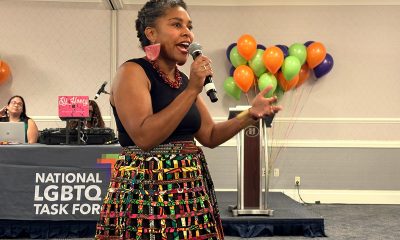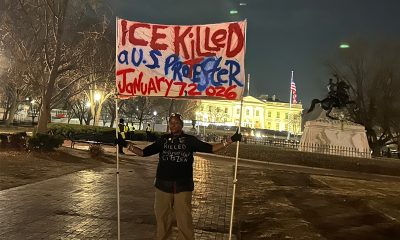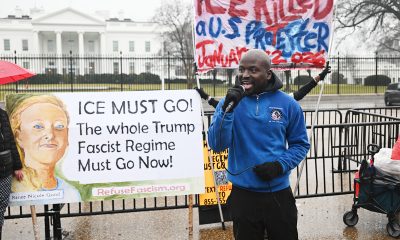Local
An end to Kameny burial stalemate?
‘Tentative agreement’ could clear way for interment of activist’s ashes
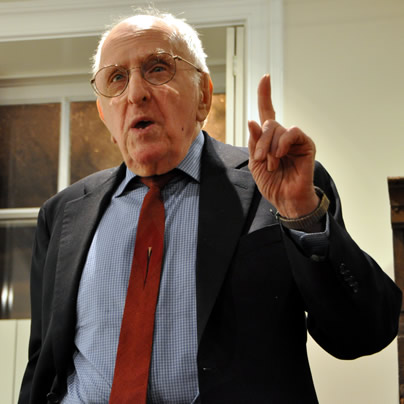
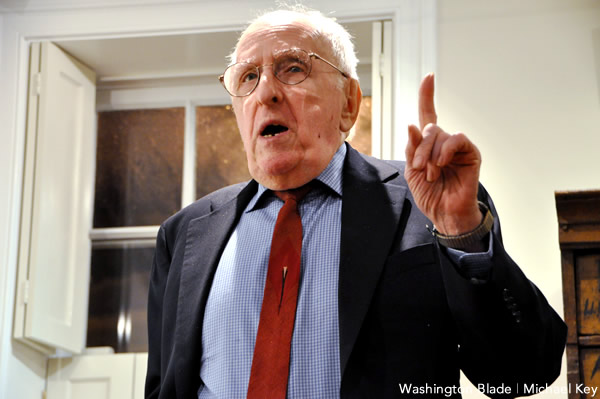
Frank Kameny died in October 2011 but his ashes remain in limbo due to a dispute between his estate and a local non-profit. (Washington Blade photo by Michael Key)
An attorney representing the estate of nationally acclaimed gay rights pioneer Frank Kameny said on Wednesday that a “tentative agreement” has been reached to end a dispute that has prevented Kameny’s ashes from being interred at D.C.’s Congressional Cemetery nearly two years after his death.
Christopher Brown, an attorney with the gay-owned law firm Ackerman Brown, said the tentative agreement was reached on July 9 with Helping Our Brothers and Sisters (HOBS), a local LGBT charitable group that bought a plot for the burial of Kameny’s ashes at Congressional Cemetery after soliciting donations from the community to pay for it following Kameny’s death on Oct. 11, 2011.
Brown’s comment came one day after Ackerman Brown’s client, Timothy Clark, Kameny’s longtime friend and heir to his estate, told the Blade that he understood that an agreement between the two parties over the cemetery plot had been reached.
“We reached an agreement on that so I’m going to keep the burial plot,” Clark said in a telephone interview.
“I just have to decide on when I want to have something,” he said in referring to a burial ceremony at the cemetery. “I just don’t know. But I’m open to any suggestions that anybody wants to have because that was Frank’s life. The gay community was Frank’s life. That’s what he fought for.”
HOBS and a group of Kameny’s friends and colleagues in the LGBT rights movement initially scheduled an interment ceremony for Kameny at the cemetery for March 3, 2012. But they abruptly cancelled it after the estate reportedly told the cemetery it would not release Kameny’s ashes until it obtained legal ownership of the burial plot from HOBS.
For more than a year, HOBS and Ackerman Brown have declined to publicly disclose specific details of the nature of the dispute between the two parties over the burial plot other than to say they were negotiating an agreement to enable HOBS to transfer ownership of the plot to the estate.
“[W]e would point out that HOBS has never stood in the way of or delayed the burial of Dr. Kameny’s ashes,” said HOBS President Marvin Carter in an email to the Blade earlier this month. “HOBS has made numerous proposals and overtures to the Kameny estate to have Dr. Kameny’s remains buried at Congressional Cemetery.”
Brown told the Blade in an email on Wednesday that the estate, which is in possession of Kameny’s ashes, also is interested in moving ahead with the burial.
“The estate has always been, and remains willing to work with gay community representatives who knew Frank Kameny in organizing a burial service and appropriate gravesite at which members of the community could pay tribute to Kameny,” Brown said in his email.
In response to a request from the Blade last month, HOBS on Wednesday released information about the money it raised and spent both for Kameny’s personal needs in the last years of his life and for expenses related to Kameny’s funeral and planned burial.
HOBS’s IRS 990 finance reports filed with the IRS for 2010 and 2011 – the most recent such reports publicly available for HOBS – don’t include specific information about money raised for Kameny-related projects.
But the reports show that HOBS’s income increased dramatically in 2010 and 2011 during a period when the non-profit, tax-exempt group and its supporters appealed to the LGBT community for Kameny-related donations — initially to help Kameny pay household expenses and property taxes and later for Kameny’s funeral and burial.
The 990 reports, which all tax-exempt organizations are required to file, show that HOBS’s income was $2,125 in 2008, the first year for which such figures are reported, and $6,544 in 2009. The reports show that in 2010, HOBS’s income rose to $61,480 and in 2011 its income increased to $115,440.
In an op-ed column published in the Blade just before the Thanksgiving holiday in November 2011, Carter discussed efforts by HOBS and other groups and individuals to arrange two separate memorial services for Kameny, one of which was held at the Carnegie Library building in downtown D.C.
“Thus far, with the generosity of many friends, we have covered expenses for Kameny’s viewing at Carnegie Library and his essential funeral costs, too,” which Carter later explained involved paying for Kameny’s cremation and the rental of a casket and the service of a funeral hearse for the viewing ceremony.
“In addition, we have now paid the deposit on a fitting, public gravesite for Kameny at the historic Congressional Cemetery,” he said in the op-ed. “For all who wish to help raise the remaining $4,000 anticipated; you may make your tax-deductible contribution online…or simply mail a check to HOBS…”
The Blade and other local publications also published stories on HOBS’s Kameny-related fundraising activities for the funeral and burial and efforts by HOBS to help Kameny prior to his death.
One effort organized by local gay activist Ben Carver in 2010 was billed as the “Buy Frank a Drink” campaign, which Carver promoted on a Facebook page.
HOBS’s 990 report for 2012, which would include that year’s income, has yet to be released by the charitable watchdog group Guidestar.com, which obtains 990 reports for nearly all U.S. non-profit groups each year from the IRS. HOBS’s 990 report for 2010 was filed in November 2011, and its 2011 report was filed in November 2012. This suggests that its 2012 990 report will likely be filed in November of this year.
The 2011 report shows that HOBS during that year spent $66,413 on “direct support to qualified individuals,” $20,222 on “mentoring programs,” and $11,605 on “educational programs.”
Those three programs, which came to a total of $98,240, accounted for the bulk of HOBS’s expenditures for that year. The 2011 report shows that all other expenses were under $4,000 and were for administrative and overhead expenses such as supplies ($3,727), board meetings ($1,007), Internet ($1,555), meals and entertainment ($505), and telephone ($1,494). More detail on those reported expenses wasn’t available.
Carter discussed HOBS’s mission in an email he sent the Blade on July 24, which also provided information about money HOBS raised and spent on Kameny-related projects.
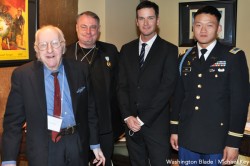
The late Frank Kameny (left) standing next to Marvin Carter at a HOBS benefit dinner in 2010. (Washington Blade file photo by Michael Key)
HOBS “is an all-volunteer micro-charity that helps marginalized LGBT individuals in our community to meet short-term and often life-sustaining needs,” Carter said. “We focus on helping those who often do not fit the criteria for help from other organizations or agencies – filling gaps in human distress here in Washington, D.C. A sizable portion of our work involves discrimination cases too, many involving torture and asylum,” said Carter, referring to cases noted on the group’s website in which HOBS assists LGBT foreign nationals seeking U.S. political asylum to escape persecution in their home country.
“Before his passing, HOBS assisted Dr. Kameny frequently with some of his essential needs, including transportation for doctor’s appointments, the use of a mobile phone, groceries and meals, urgent bathroom plumbing repairs, repair of his eyewear, and the payment of past property tax bills to prevent his home foreclosure – spending in total thousands of dollars in the years before his death,” Carter said.
Carter provided these figures and related information in connection with the contributions HOBS received and expenditures it incurred for Kameny-related projects in 2010 and 2011:
- Contributions earmarked by donors for Kameny’s burial expenses totaled about $800.
- Other donors “make clear that their donations may be used for HOBS’ general mission,” were silent about how to use the donations.
- During this period, “approximately $15,000 was raised in connection with our general fundraising efforts.”
- HOBS incurred expenses totaling approximately $8,500 related to the purchase of a cemetery plot for Kameny at Congressional Cemetery, cremation expenses and “other expenses of the funeral home (including rental of a casket and hearse for transporting Dr. Kameny’s ashes to the memorial service…and a gravesite marker reading ‘Gay is Good.’”
- There was no surplus of funds from contributions for Kameny’s burial and memorial service efforts. HOBS used money from its general operating account to cover the Kameny funeral and burial expenses not covered by earmarked donations.
- HOBS did not solicit funds for payment of Kameny’s property taxes in 2011. It did raise money for and contributed to Kameny’s property tax payments in 2010.
Virginia
Mark Levine loses race to succeed Adam Ebbin in ‘firehouse’ Democratic primary
State Del. Elizabeth Bennett-Parker won with 70.6 percent of vote
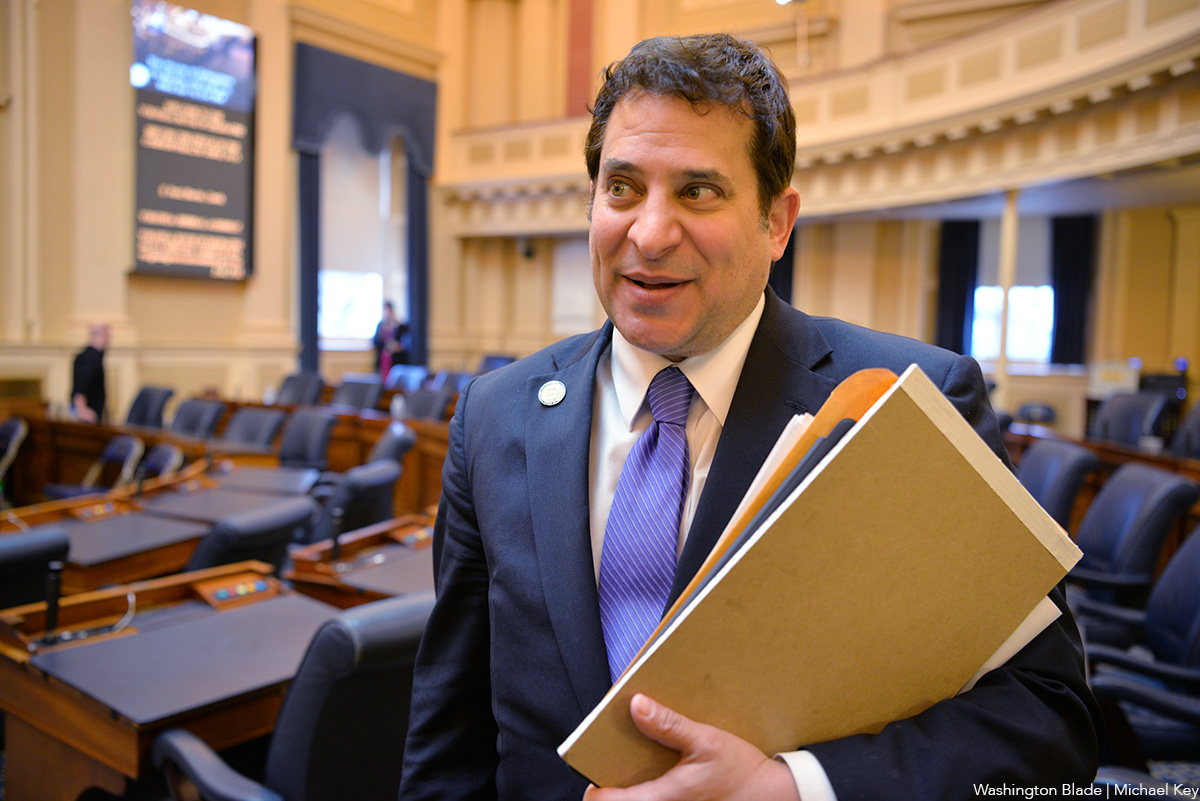
Gay former Virginia House of Delegates member Mark Levine (D-Alexandria) lost his race to become the Democratic nominee to replace gay state Sen. Adam Ebbin (D-Alexandria) in a Jan. 13 “firehouse” Democratic primary.
Levine finished in second place in the hastily called primary, receiving 807 votes or 17.4 percent. The winner in the four-candidate race, state Del. Elizabeth Bennett-Parker, who was endorsed by both Ebbin and Gov.-elect Abigail Spanberger received 3,281 votes or 70.6 percent.
Ebbin, whose 39th Senate District includes Alexandria and parts of Arlington and Fairfax Counties, announced on Jan. 7 that he was resigning effective Feb. 18, to take a job in the Spanberger administration as senior advisor at the Virginia Cannabis Control Authority.
Results of the Jan. 13 primary, which was called by Democratic Party leaders in Alexandria, Arlington, and Fairfax, show that candidates Charles Sumpter, a World Wildlife Fund director, finished in third place with 321 voters or 6.9 percent; and Amy Jackson, the former Alexandria vice mayor, finished in fourth place with 238 votes or 5.1 percent.
Bennett-Parker, who LGBTQ community advocates consider a committed LGBTQ ally, will now compete as the Democratic nominee in a Feb. 10 special election in which registered voters in the 39th District of all political parties and independents will select Ebbin’s replacement in the state senate.
The Alexandria publication ALX Now reports that local realtor Julie Robben Linebery has been selected by the Alexandria Republican City Committee to be the GOP candidate to compete in the Jan. 10 special election. According to ALX Now, Lineberry was the only application to run in a now cancelled special party caucus type event initially called to select the GOP nominees.
It couldn’t immediately be determined if an independent or other party candidate planned to run in the special election.
Bennett-Parker is considered the strong favorite to win the Feb. 10 special election in the heavily Democratic 39th District, where Democrat Ebbin has served as senator since 2012.
District of Columbia
Ruby Corado sentenced to 33 months in prison
Former Casa Ruby director pleaded guilty to wire fraud in 2024
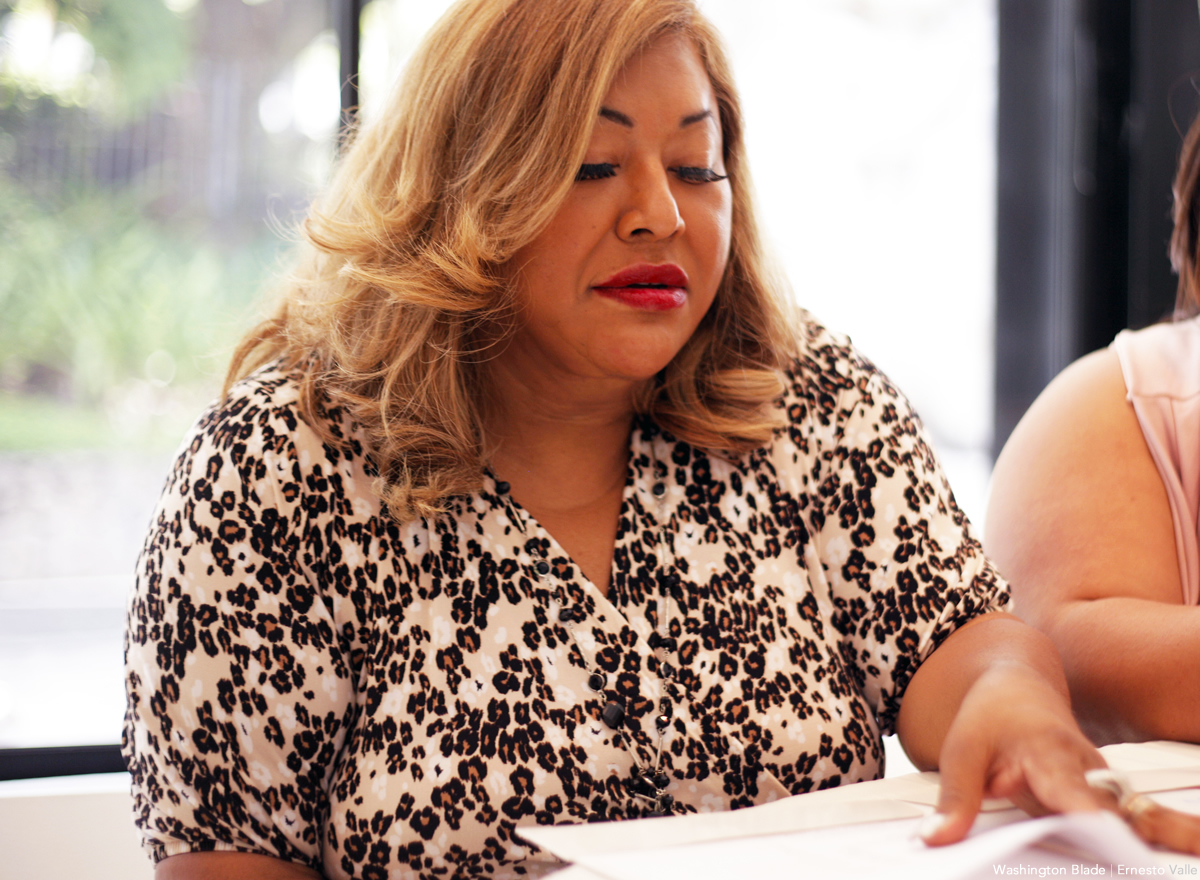
A federal judge on Jan. 13 sentenced Ruby Corado, the founder and former executive director of the now closed D.C. LGBTQ community services organization Casa Ruby, to 33 months of incarceration for a charge of wire fraud to which she pleaded guilty in July 2024.
U.S. District Court Judge Trevor M. McFadden handed down the sentence that had been requested by prosecutors with the Office of the U.S. Attorney for the District of Columbia after Corado’s sentencing had been postponed six times for various reasons.
The judge also sentenced her to 24 months of supervised release upon her completion of incarceration.
In addition to the sentence of incarceration, McFadden agreed to a request by prosecutors to hold Corado responsible for “restitution” and “forfeiture” in the amount of $956,215 that prosecutors have said she illegally misappropriated from federal loans obtained by Casa Ruby.
The charge to which she pleaded guilty is based on allegations that she diverted at least $180,000 “in taxpayer backed emergency COVID relief funds to private offshore bank accounts,” according to court documents.
Court records show FBI agents arrested Corado on March 5, 2024, at a hotel in Laurel, Md., shortly after she returned to the U.S. from El Salvador, where authorities say she moved in 2022. Prosecutors have said in charging documents that she allegedly fled to El Salvador, where she was born, after “financial irregularities at Casa Ruby became public,” and the LGBTQ organization ceased operating.
Shortly after her arrest, another judge agreed to release Corado into the custody of her niece in Rockville, Md., under a home detention order. But at an Oct. 14, 2025, court hearing at which the sentencing was postponed after Corado’s court appointed attorney withdrew from the case, McFadden ordered Corado to be held in jail until the time of her once again rescheduled sentencing.
Her attorney at the time, Elizabeth Mullin, stated in a court motion that her reason for withdrawing from the case was an “irreconcilable breakdown in the attorney-client relationship.”
Corado’s newly retained attorney, Pleasant Brodnax, filed a 25-page defense Memorandum in Aid of Sentencing on Jan. 6, calling for the judge to sentence Corado only to the time she had already served in detention since October.
Among other things, Brodnax’s defense memorandum disputes the claim by prosecutors that Corado improperly diverted as much as $956,215 from federally backed loans to Casa Ruby, saying the total amount Corado diverted was $200,000. Her memo also states that Corado diverted the funds to a bank account in El Salvador for the purpose of opening a Casa Ruby facility there, not to be used for her personally.
“Ms. Corado has accepted responsibility for transferring a portion of the loan disbursements into another account she operated and ultimately transferring a portion of the loan disbursements to an account in El Salvador,” the memo continues.
“Her purpose in transferring funds to El Salvador was to fund Casa Ruby programs in El Salvador,” it says, adding, “Of course, she acknowledges that the terms of the loan agreement did not permit her to transfer the funds to El Salvador for any purpose.”
In his own 16-page sentencing recommendation memo, Assistant U.S. Attorney John Borchert, the lead prosecutor in the case, said Corado’s action amounted at the least to fraud.
“The defendant and Casa Ruby received no less than $1.2 million in taxpayer backed funds during the COVID-19 global health crisis,” he memo states. “But rather than use those funds to support Casa Ruby’s mission as the defendant promised, the defendant further contributed to its demise by unlawfully transferring no less than $180,000 of these federal emergency relief funds into her own private offshore bank accounts,” it says.
“Then, when media reports suggested the defendant would be prosecuted for squandering Casa Ruby’s government funding, she sold her home and fled the country,” the memo states. “Meanwhile, the people who she had promised to pay with taxpayer-backed funds – her employees, landlord, and vendors – were left behind flat broke.”
A spokesperson for the U.S. Attorney’s office and Corado’s attorney didn’t immediately respond to a request from the Washington Blade for comment on the judge’s sentence.
“Ms. Corado accepts full responsibility for her actions in this case,” defense attorney Brodnax says in her sentencing memo. “She acknowledges the false statements made in the loan applications and that she used some of the money outside the United States,” it says.
“However, the money was still utilized for the same purpose and intention as the funds used in the United States, to assist the LGBTQ community,” it states. “Ms. Corado did not use the money to buy lavish goods or fund a lavish lifestyle.”
Brodnax also states in her memo that as a transgender woman, Corado could face abuse and danger in a correctional facility where she may be sent if sentenced to incarceration.
“Ruby Corado committed a crime, she is now paying the price,” said D.C. LGBTQ rights advocate Peter Rosenstein. “While it is sad in many ways, we must remember she hurt the transgender community with what she did, and in many ways they all paid for her crime.”
Virginia
Woman arrested for anti-gay assault at Alexandria supermarket
Victim recorded video of Christmas Day attack

Alexandria police announced on Jan. 12 that a Maryland woman has been arrested for allegedly assaulting a man while shouting anti-gay slurs at him at a Giant supermarket in Alexandria on Christmas Day.
The arrest came after a video of the assault that the victim captured with his phone and on which the woman can be heard shouting anti-gay slurs went viral on social media.
Police identified the woman as Shibritney Colbert, 34, of Landover, Md. Alexandria Police Chief Tarrick McGuire stated at a news conference that police responded to a 911 call placed by the victim and attempted to apprehend the woman, but she drove off in her car before police could apprehend her.
He said following an investigation, Colbert was apprehended and arrested in Prince Goerge’s County, Md., on Jan. 8. He said arrangements were being made for her to be brought to Alexandria where she was expected to face charges of assault and battery, destruction of property, felony eluding, and driving an unregistered vehicle.
The video of the incident shows Colbert pushing a shopping cart she was using in an aisle at the Giant store, located at 3131 Duke St., into the victim and another woman who was trying to help the victim. She can be seen throwing groceries at the victim while shouting anti-gay names. “Boy, get out of here with your gay ass,” was among the words she yelled at him that could be heard on the video.
The victim, who police identified only as a 24-year-old man, could be heard on the video saying he does not know the woman and urging her to “please back up.”
“Based on the victim’s statement, comments exchanged prior to the assault, and the totality of the circumstances, investigators believe the victim was targeted because of his sexual orientation,” police said in a statement.
Tarrick said Colbert’s arrest came at a time when Alexandria police were completing a strengthened hate crime policy calling for detectives to investigate crimes based on hate and for the department to prepare reports on hate crimes twice a year.
“Hate crimes are not just crimes against individuals, they are offenses that threaten the entire community and undermine the fundamental principles of dignity, equality, and safety,” Tarrick said.
Alexandria police didn’t immediately respond to a request from the Washington Blade for a copy of the official police report on the incident.
A link to the video posted on the social media site Reddit in which an unidentified man provides some details of the attack, can be accessed here:



